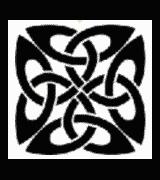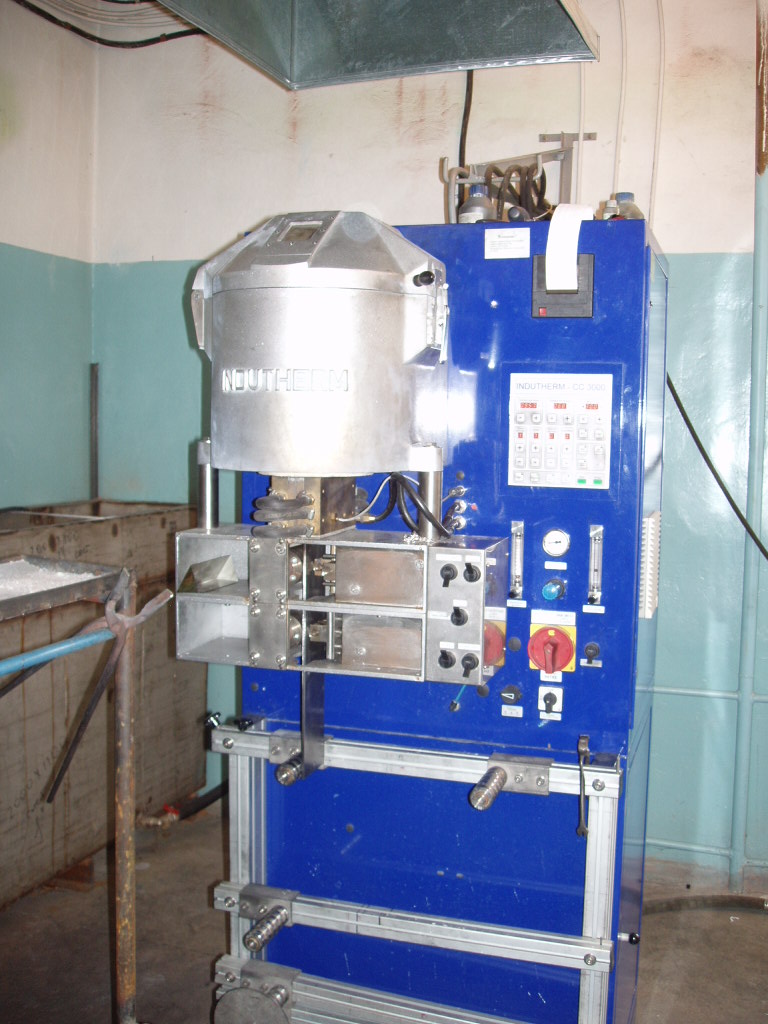 Manufacturing of the silver alloys profiles in vertical
continuous installation
Manufacturing of the silver alloys profiles in vertical
continuous installation
The Modern requirements claimed to the quality of the deformed profiles made from precious metals (PM) and their alloys define the necessity of qualitative cast billet. One of the most efficient, in a short-run manufacturing of the PM profiles, is a method of vertical continuous casting. Multifunctional installation of vertical continuous casting (IVCC) have well proved themselves at domestic enterprises, manufacturing precious metals products. CC 3000 installation INDUTHERM, Germany (Fig. 1) is one of them. It allows to produce not only the cast profiles of different dimensions, but to get a vacuum-treated metal as well. The use of such equipment raises significantly the output of finished products, reduces the PM losses and the product prime cost. However, the installations are not provided with technological means for manufacturing of standardized PM alloys on territory of the Ukraine.

Fig 1 - Installation of vertical continuous casting, CC 3000
The influence of the process parameters of the casting process on the quality of cast silver alloys semiproducts Pcr65 and Pcr45 (the GOEST 19738-74) was investigated.
The alloys were prepared beforehand in a resistance furnace in a graphite crucible according to existing technology. In continuous casting the melting was conducted in inert atmosphere (argon) of the induction furnace of the CC 3000 installation in graphite crucible of 20 kg silver capacity.
To form the profiles the copper watercooled molds with graphite inserts were used for shaping three billets: band 100?5 mm; wire d=29 mm and five strands d=4 mm.
In the process of experiment the following technological parameters were varied: the melt temperature, the mode of the mould cooling, time of holding, the drawing pitch, the inert gas pressure in the furnace. The melt mixing at different stages of the process was supported in automatic or manual mode. The table 1 gives results received.
The visual inspection of continuously cast billet has shown that their surface is clean, smooth, without cracks and noncasts. Slag and nonmetalic inclusions are not found on the surface.
Table 1- Technological modes of silver alloys continuous casting in CC 3000 installation
| Grade of alloy | Type of billet | Temperature of mould, ?Ñ | Temperature of meit ?Ñ | Pitch of drawing, ìì | Time of pause, s |
| PCr 65 | band 5*100 mm | 78 | 860 | 1 | 0,7 |
| PCr 45 | rod d=29 mm | 60 | 860 | 1 | 0,4 |
| PCr 45 | wire d=4 mm | 65 | 830 | 1 | 0,7 |
| PCr 45 | wire d=4 mm | 75 | 830 | 2 backspacing 1 | 0,6 |
The alloys, comprising zinc (PCr 65, PCr 45), are hard to process during the casting in CC 3000 installation. The frequent cases of the cold breaks of the mentioned alloys profiles are found in the mould, that is due, in the first place, to the excess of friction between metal and the mould material.PCr 65 and PCr 45 alloy profiles were drawn with minimum pitch, at narrow interval of the melt temperature, at the highest temperature of the mould, with the use of additional lubrificant of the mould and excessive argon pressure in working chamber.
It was determined that alloys of the ÏÑð 65 and ÏÑð 45 type wear out the working surface of the mould graphite inserts much more quickly, than the other researched materials.
The best surface quality was received in the half-finished products cast at minimumdrawing pitch or when the inverse drawing pitch was used in the cycle.
The use the excess argon pressure in the melting chamber gives a positive result, expressed in a significant reduction of cold breaks. Basically this mode was used for casting of the 4 mm wire, as well as for casting of the 100*5 mm PCr 65 alloys.
The quality of the profile metal macro- and microstructure of alloys were investigated by the method to qualitative metallography.
Qualitative metallographic analysis of the alloys microstructure was conducted on metallographic microscope "NEOPHOT-30" and REM "CAMEBAX".
As a result of metallographic analysis it was found that metal of the profiles cast in CC 3000 installation is solid, free from pores and foreign inclusions. The copper protoxides in coppercomprising alloys are not discovered. The morphology of structurel constituents of alloys in continuously cast billets is different from that, poured in metallic chill mould by the particle dispersion and their orientation in accordance with the direct front to crystallization in continuous casting. The differences in phase composition of investigated alloys, cast in chill mould or in CC 3000 installation, are not discovered. It was found the presence of dendritic segregation of elements in alloys of the billets, cast in chill mould and its practically absence in continuously cast alloys. Macro and microstructure of alloys in continuously cast billets are characterized by technologically favourable morphology of structurel constituents for further plastic working. The results of metallographic analysis are confirmed by the results of the tests of the alloys mechanical properties. The uniaxial tensile test of continuously cast wire was conducted in accordance with GOEST 10446-80 using universal tensile-testing machine 123Ó-10. The results of the mechanical tests are given in table 2.
Table 2 - Mechanical properties of the 4 ìì silver alloy wire
| Grade of alloy | Mechanical properties | ||
| ?â, MPa | ?0,2, MPa | ?0,2, % | |
| PCr 45 | 460 | 329 | 22,0 |
Billets cast in CC 3000 installation were sent on route to plastic forming to manufacture the wire and the band from silver and its alloys.
Cold and hot plastic forming of continuously cast silver alloys billets have shown the significant advantage over the cast by pouring in metal chill moulds. As a result, the use the billets produced by continuous casting method significantly improved the quality of finished products, greatly increased the output of metal and reduced loss of PM. The routes of plastic forming are reduced, the number of the intermediate termal treatments is decreased.